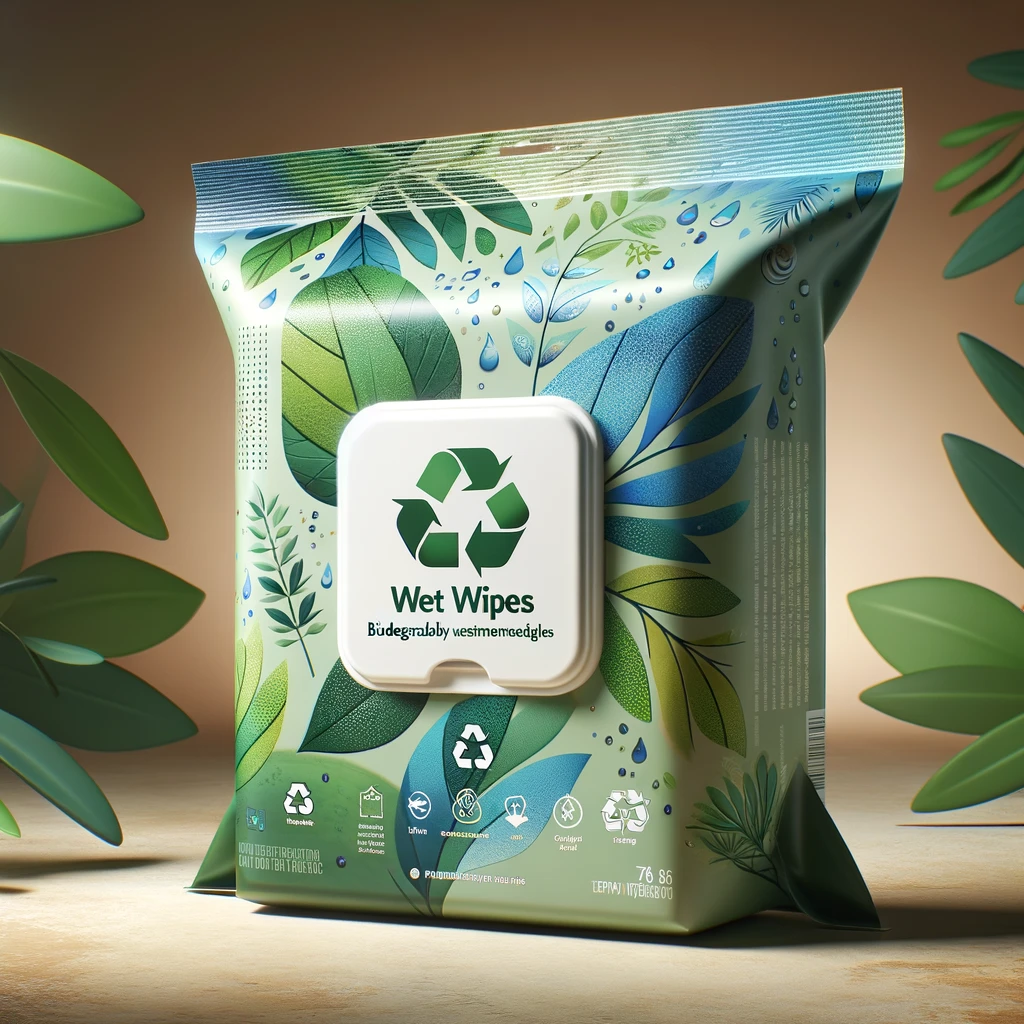The Composition of Wet Wipes
Wet wipes are manufactured using non-woven materials that are fused using several techniques including chemical, mechanical, or thermal processes. The fibers used in the wipe are essential for ensuring both durability and softness, which are important for good cleaning without creating any skin discomfort. The non-woven material is selected for its durability in wiping and its ability to absorb the liquid solution that provides wet wipes with their distinctive cleaning qualities.
The liquid solution included in wet wipes is a meticulously crafted combination of substances that aims to optimize cleaning effectiveness while guaranteeing user safety. The main constituent of this solution is water, which functions as a solvent to dissolve dirt and debris. To augment the efficacy of the cleaning process, detergents or surfactants are included. These compounds facilitate the decomposition of oils and grease, hence simplifying their removal from surfaces or skin. Surfactants function by decreasing the surface tension of water, thus enhancing its ability to disperse and infiltrate more efficiently.
Aside from water and detergents, many wet wipes also use alcohol or other disinfectants. Alcohol has exceptional efficacy in eradicating germs and viruses upon contact, making these wipes indispensable in hospital environments and for personal hygiene during periods of disease epidemics. Certain wipes may additionally include benzalkonium chloride or other antimicrobial compounds that provide extended protection against the development of microorganisms, hence increasing the longevity of the wipe’s efficacy even after it has been used.
Wet wipes designed for personal use often include moisturizers and skin conditioners. Ingredients such as aloe vera, glycerin, and vitamin E provide a soothing and protective effect on the skin, avoiding dryness and irritation that may occur due to continuous wiping. The use of these chemicals enhances the suitability of wet wipes for delicate purposes, such as infant care or face washing, where the utmost importance is placed on providing gentle care.
Wet wipes can include fragrances and preservatives as well. Aromas provide a pleasant fragrance, improving the user’s experience, while preservatives guarantee the durability of the product by inhibiting the development of microorganisms within the container. Nevertheless, producers must meticulously strike a balance between these components to prevent any allergic responses or skin sensitivities in consumers.
The composition of wet wipes is carefully engineered, using a combination of different materials and chemicals to reach an ideal mix of cleaning effectiveness, safety, and user comfort. Every component has a vital function in guaranteeing the efficacy of wet wipes as versatile instruments for maintaining hygiene and cleanliness in various applications.
Cleaning Power of Wet Wipes
Wet wipes are well recognized for their multifunctional cleaning powers, which arise from their distinctive composition and design. The efficacy of wet wipes in cleaning is due to the synergy between their non-woven fabric and the specifically prepared solution they contain. This collaboration enables them to efficiently address a wide range of cleaning chores, including both personal hygiene and surface disinfection.
Surface Cleaning
Wet wipes are very effective and convenient for surface cleaning. The non-woven fabric is specifically engineered to ensnare and elevate particles of dirt, dust, and debris from various surfaces. The physical action is intensified by the solution impregnated into the wipes, which usually include detergents or surfactants. These chemicals function by decomposing oils and dirt, facilitating their removal by wiping. This two-fold cleaning method guarantees that surfaces are devoid not just of evident filth but also of any remnants that may foster germs or allergies. Wet wipes provide a convenient and efficient solution for keeping various surfaces, such as kitchen countertops, bathroom sinks, and business desks, clean and hygienic.
Personal Hygiene
Within the domain of personal hygiene, wet wipes provide a pragmatic remedy for cleansing the skin in situations when conventional approaches, such as soap and water, are inaccessible. They are especially favored for newborn care because of their mild composition, which guarantees the cleansing of delicate skin without causing discomfort. Moisturizers and skin conditioners added to personal hygiene wipes serve to maintain skin hydration and provide protection. Wet wipes may be a practical choice for adults to quickly freshen up when traveling, after exercising, or in circumstances that need urgent cleansing. Their small and convenient packaging facilitates portability, guaranteeing the availability of a dependable cleaning solution at all times.
Antibacterial Properties
Wet wipes include antibacterial qualities that greatly boost their cleaning effectiveness. Several wet wipes include antibacterial chemicals that effectively target a wide range of microorganisms. These wipes are crucial in healthcare environments, where they are used to sanitize hands, surfaces, and medical equipment. The capacity to rapidly and effectively eliminate microorganisms aids in minimizing the likelihood of illnesses, especially in settings where cleanliness is of utmost importance. Antibacterial wipes provide an additional level of defense for daily usage, effectively inhibiting the transmission of microorganisms in public areas, households, and work environments.
Virus Removal
Some wet wipes not only have antibacterial qualities but are also specifically designed to be virucidal, meaning they may inactivate viruses upon contact. This skill is especially crucial during viral epidemics, such as the influenza season or the COVID-19 pandemic. Virucidal wipes aid in diminishing the spread of infections by sanitizing commonly touched surfaces, such as doorknobs, mobile phones, and handrails. Utilizing them may greatly reduce the probability of viral transmission, rendering them an essential instrument in public health endeavors to manage contagious illnesses.
Specialized Applications
Wet wipes are designed for certain purposes, allowing their cleaning effectiveness to be customized to match particular requirements. Automotive wipes are specifically formulated to cleanse and safeguard the interiors of vehicles. These wipes include a blend of cleaning agents and conditioners that effectively remove dirt and grime while leaving surfaces with a polished and rejuvenated appearance. Industrial wipes are specifically designed to effectively remove stubborn dirt, such as grease and oil, which makes them essential in manufacturing and maintenance environments. These specialty wipes exemplify the multifunctionality and flexibility of wet wipes in effectively tackling diverse cleaning obstacles.
Ultimately, the efficacy of wet wipes in cleaning is a direct consequence of their meticulous construction and formulation. They provide a dependable and efficient remedy for a diverse array of cleaning duties, spanning from personal cleanliness to the sanitization of surfaces. Their capacity to integrate manual cleaning with chemical action makes them essential in maintaining hygiene and cleanliness in many settings.
Disinfecting Capabilities
Wet wipes are highly valued not just for their ability to clean well but also for their remarkable disinfection properties. These qualities make them essential in both regular use and specialist environments, where cleanliness and security are of utmost importance. The disinfection effects of wet wipes are mostly derived from their active components, which are specifically formulated to eradicate or impede the proliferation of detrimental microorganisms, such as bacteria, viruses, and fungi.
Antibacterial Properties
A considerable proportion of wet wipes are prepared with antibacterial chemicals, particularly engineered to selectively target and eradicate germs. Agents like benzalkonium chloride or alcohol function by breaking the cell membranes of bacteria, resulting in their demise. Ensuring the prevention of infection transmission is of utmost importance, especially in environments where the maintenance of a sterile atmosphere is critical, such as hospitals and clinics. Wet wipes are used in these settings to sanitize medical equipment, tidy patient rooms, and preserve hand hygiene. Due to their quick response and user-friendly nature, they are considered the primary means of protection against bacterial infection.
Virus Removal
The efficacy of wet wipes in eliminating and inactivating viruses is another crucial component of their disinfectant properties. Viruses provide a greater challenge for elimination compared to bacteria because of their resilient protein coverings. However, some wet wipes are endowed with virucidal capabilities, enabling them to efficiently kill viruses. These wipes often include ingredients such as ethanol or isopropyl alcohol, which are very efficient against a broad spectrum of viruses, including those that cause respiratory illnesses such as the flu and COVID-19. By applying these wipes to regularly contacted surfaces, such as door knobs, light switches, and electronic gadgets, the likelihood of viral transmission may be greatly reduced.
Fungal Control
Wet wipes may be designed to battle fungus, along with bacteria and viruses. Fungal infections, which may impact both dermal and surface areas, are a prevalent issue in diverse settings, such as fitness centers, changing rooms, and communal bathing facilities. Wet wipes specifically formulated for fungal management often include antifungal chemicals that may impede the development of mold, mildew, and yeasts. This guarantees a thorough strategy for cleanliness, including a wider range of disease-causing microorganisms that might lead to health problems.
Practical Applications in Healthcare
The disinfection properties of wet wipes are crucial in healthcare environments. They are often used to disinfect surfaces and equipment that have direct contact with patients. This encompasses a wide range of items, ranging from examination tables and surgical tools to wheelchairs and hospital beds. Regularly using disinfectant wipes significantly decreases the occurrence of healthcare-associated infections (HAIs), a significant issue within hospital settings. Wet wipes are crucial in maintaining patient safety and preventing the spread of infections by keeping surfaces free from hazardous germs.
Everyday Use and Public Spaces
In addition to healthcare, the antimicrobial characteristics of wet wipes are equally crucial in many daily environments. These wet wipes provide a practical means of ensuring cleanliness and minimizing the transmission of germs in residential areas, educational institutions, workplaces, and public areas. During periods of increased prevalence of cold and flu, using disinfectant wipes on commonly used surfaces, such as desks, phones, and keyboards, may effectively reduce the likelihood of contracting an infection. Wet wipes are crucial in maintaining cleanliness in public toilets and transit hubs, particularly in places that are often touched. They provide reassurance to consumers by ensuring that these surfaces are hygienic.
Environmental Considerations
Although wet wipes possess notable disinfection capabilities, it is crucial to take into account their ecological ramifications. A significant drawback of typical disinfection wipes is that they are composed of non-biodegradable synthetic fibers, which leads to increased waste and pollution. Nevertheless, there is an increasing inclination towards adopting more environmentally friendly alternatives, as wet wipes manufacturers are creating biodegradable and compostable wipes that uphold rigorous disinfection requirements while also being more environmentally conscious. Consumers are advised to choose these environmentally friendly alternatives and to properly dispose of wet wipes to reduce environmental damage.
To summarize, the disinfectant properties of wet wipes make them a crucial instrument in maintaining cleanliness and halting the transmission of contagious illnesses. Due to their efficacy against bacteria, viruses, and fungi, they may be used in many environments to enhance health and safety. Given the increasing need for efficient disinfection, wet wipes will continue to play a vital role in maintaining cleanliness standards, benefiting both public health and individual well-being.
Specific Applications in Hygiene and Health
Wet wipes are now essential in many hygiene and wellness routines since they are versatile, convenient, and effective. Wet wipes have diverse uses in many contexts, including healthcare institutions and personal usage, since they provide distinct features that are advantageous in each context. This section examines the many ways in which wet wipes play a role in preserving cleanliness and well-being in different settings.
Medical Facilities
Wet wipes play a crucial function in healthcare settings. They are widely used to maintain a sterile environment, which is essential for reducing healthcare-associated infections (HAIs). Disinfecting wet wipes is a crucial tool for medical personnel to cleanse and sterilize medical equipment, surfaces, and spaces dedicated to patient care. Wet wipes are used to sanitize stethoscopes, blood pressure cuffs, and other regularly touched instruments after each usage. This practice aids in interrupting the transmission of pathogens and guaranteeing the safety of medical tools for patient use. In addition, wet wipes are used for hand hygiene, providing a convenient and efficient method for healthcare professionals to cleanse their hands during patient contacts when soap and water are not readily accessible.
Daycare and Schools
Wet wipes are often used in daycares and schools to provide a hygienic atmosphere, which is crucial for the well-being and protection of children. These environments are susceptible to the transmission of pathogens because of the proximity and frequent exchange of toys and materials among youngsters. Wet wipes serve the purpose of cleansing hands, wiping toys, and disinfecting surfaces, hence aiding in the prevention of disease transmission. The soft compositions of these wipes guarantee their suitability for the delicate skin of youngsters, offering a pleasant but efficient cleansing solution. By integrating wet wipes into daily regimens, caregivers and educators may effectively diminish the occurrence of prevalent diseases, such as colds and stomach viruses, among youngsters.
Travel and Outdoor Activities
Wet wipes are a convenient and portable option for travelers and outdoor lovers to maintain hygiene while on the go. Soap and water may be scarce whether traveling by aircraft, hiking, or camping. Wet wipes provide a practical substitute for handwashing, refreshing the face, and maintaining basic personal cleanliness. These may be used for sanitizing surfaces in public spaces, such as airline trays and bus seats, hence decreasing the likelihood of coming into contact with harmful microorganisms. Wet wipes are very useful in outdoor environments for cleansing hands before to eating, after toilet use, or after coming into contact with possibly contaminated items. Their small and efficient packaging allows for convenient portability, guaranteeing that tourists can maintain hygiene regardless of their whereabouts.
Personal Hygiene and Baby Care
Wet wipes are essential for maintaining personal cleanliness, especially when it comes to caring for babies. Parents depend on baby wipes to cleanse and safeguard their baby’s skin during diaper changes, preventing irritation. These wipes are specifically designed to be mild for sensitive skin, and often include calming components such as aloe vera and chamomile. Wet wipes provide a handy solution for people to refresh themselves during the day, remove makeup, or tidy up after physical activity. They are particularly beneficial for persons with limited movement or those who are confined to bed, providing a straightforward and efficient method to maintain personal hygiene.
Food Service and Hospitality
Wet wipes are vital in the food service and hospitality sectors for maintaining stringent cleanliness requirements. Restaurants and cafés use disinfectant wipes to sanitize tables, menus, and condiment containers after each client, thereby inhibiting the transmission of germs. Wet wipes are used in kitchens to disinfect food preparation surfaces and equipment, guaranteeing their freedom from impurities. Hotels and guest accommodations often provide wet wipes as part of their amenities, providing visitors with a handy means to refresh themselves and maintain cleanliness during their stay. By integrating wet wipes into their cleaning protocols, these industries may improve their hygiene procedures and provide a more secure environment for consumers and visitors.
Gyms and Fitness Centers
Gyms and fitness facilities are densely populated spaces where the likelihood of germ transmission is substantial. Wet wipes are used to sanitize and disinfect gym equipment, including treadmills, weights, and yoga mats, after each usage. This technique aids in mitigating the transmission of germs and viruses among those who frequent the gym. In addition, moist wipes are provided for personal use, enabling persons to sanitize equipment before and after use, guaranteeing its cleanliness and readiness for the next user. Gyms may improve their hygiene practices and create a healthier atmosphere for their members by encouraging the usage of wet wipes.
Overall, the many and extensive uses of wet wipes in promoting cleanliness and well-being are evident. Their adaptability, efficiency, and ease make them an essential instrument in many contexts. Wet wipes are essential for preserving cleanliness and reducing the transmission of illnesses in several industries such as healthcare, education, travel, personal care, food service, and fitness. With the ongoing evolution of hygiene standards, the demand for wet wipes is expected to increase, emphasizing their crucial role in promoting health and well-being.
Environmental Considerations
Although wet wipes provide substantial advantages in terms of cleanliness and ease of use, their ecological footprint has become an increasingly worrisome issue. The extensive use of moist towelettes has resulted in several ecological problems, such as contamination, difficulties in waste disposal, and adverse effects on marine organisms. To address these problems, it is necessary to comprehend the environmental impact of wet wipes and investigate sustainable alternatives and methods.
Accumulation and Pollution of Waste
An important environmental concern related to wet wipes is the buildup of trash. A significant number of wet wipes are manufactured using non-biodegradable synthetic fibers, such as polyester and polypropylene. Improper disposal of these wipes leads to their contribution to landfill garbage and their long-lasting presence in the environment for many decades. Furthermore, the act of disposing of wet wipes by flushing them down the toilet may lead to substantial issues inside sewage systems. Contrary to toilet paper, wet wipes do not readily dissolve and might cause obstructions, leading to expensive repairs and upkeep for public wastewater treatment systems. These obstructions, often known as “fatbergs” when mixed with fats and oils, may lead to sewage overflows and environmental pollution.
Effects on Marine Life
Wet wipes that enter aquatic bodies pose a significant danger to marine life. When these wipes disintegrate into microplastics, they may be consumed by marine organisms, resulting in physical injury and chemical pollution. Microplastics can build up in the food chain, impacting both marine organisms and people who eat seafood. The existence of moist towelettes on shorelines and seas emphasizes the need for improved waste management methodologies and heightened public awareness about the ecological dangers associated with incorrect disposal.
Production and Utilization of Resources
The manufacturing process of wet wipes entails substantial use of resources, such as water, electricity, and raw materials. The production of non-woven textiles and the chemical solutions used in wet wipes may have a significant impact on the environment. In addition, the use of plastic packaging for wet wipes contributes to the overall depletion of resources and the development of trash. To effectively mitigate the environmental consequences of wet wipes, it is crucial to take into account the whole life cycle of the product, including all stages from manufacturing to disposal.
Environmentally-friendly Options
To reduce the negative environmental effects of wet wipes, researchers are now investigating several sustainable alternatives and improvements. There is a growing trend in the popularity of biodegradable and compostable wet wipes that are manufactured from natural fibers like cotton, bamboo, or viscose. These materials degrade more easily in the environment, hence decreasing long-term pollution. In addition, several wet wipes manufacturers are in the process of creating wet wipes that use less toxic substances and include eco-friendly packaging.
Consumer Accountability and Instruction
Consumers have a vital role in mitigating the environmental consequences of wet wipes. Adhering to responsible disposal practices, such as refraining from flushing wet wipes down the toilet and instead disposing of them in appropriate trash receptacles, is crucial. Public education programs can enhance knowledge and understanding of the environmental concerns linked to wet wipes, as well as promote the adoption of sustainable behaviors. Consumers may help decrease the environmental impact of wet wipes by making well-informed decisions and selecting eco-friendly goods.
Industry Initiatives and Regulations
The wet wipes business is becoming more aware of the need to implement sustainable practices. Several corporations are allocating resources to research and development to produce more environmentally friendly goods and minimize their ecological footprint. Industry activities include the implementation of sustainable sourcing practices for raw materials, the optimization of production processes to minimize waste and energy use, and the enhancement of product design to promote improved biodegradability. Regulatory actions may also have a substantial impact on resolving the environmental issues associated with wet wipes. Authorities and regulatory agencies can enforce regulations that encourage the sustainable manufacturing and disposal of wet wipes, such as prohibiting the use of non-flushable wipes or mandating explicit labeling on packages detailing appropriate disposal procedures.
Prospects for the Future
The future of wet wipes hinges on striking a delicate equilibrium between their sanitary advantages and environmental sustainability. Continuing research and innovation are expected to result in the development of novel materials and formulations that are both highly efficient and ecologically sustainable. The implementation of closed-loop systems, which include the collection and recycling of used wet wipes, has great potential in decreasing waste. To establish a sustainable system for the manufacturing and disposal of wet wipes, it is crucial to foster cooperation among wet wipes manufacturers, consumers, and politicians.
Ultimately, wet wipes provide significant advantages in terms of cleanliness and ease of use, but it is crucial to acknowledge their adverse effects on the environment. To tackle the issues of waste buildup, pollution, and resource usage, a comprehensive strategy is needed that encompasses sustainable product design, responsible consumer behavior, and supporting legislative frameworks. By adopting sustainable options and methods, the wet wipes business may fulfill hygienic requirements while reducing its environmental impact, guaranteeing a cleaner and healthier earth for future generations.






